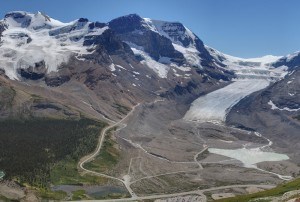
As you pour a tall glass of cold Jasper water this week, ask yourself, “Do I know my H2O?”
It’s Canada Water Week, held annually in the third week of March to coincide with World Water Day on March 22. This year’s national theme is Know Your H2O.
To learn about the importance of protecting and sustaining our waters and aquatic ecosystems from coast to coast to coast, let us get to know the very apex of Canada’s fresh water in our backyard—the Columbia Icefield.
The Columbia Icefield is the largest mass of glacial ice in the Canadian Rockies, with a total area of 200 square kilometres. Glaciers form when over many years, more snow falls in winter than melts each summer. As the snow gets thicker and heavier, it compacts into dense glacial ice that slowly flows downhill, like a river of taffy. The glaciers from the Columbia Icefield once extended through the mountains, carving out the valleys we live in today.
Known as a hydrological apex, water from the Columbia Icefield flows to three different oceans. On the British Columbia side, meltwater flows into the Columbia River and to the Pacific Ocean. On the Alberta side, the North Saskatchewan and Athabasca rivers feed into the Atlantic and Arctic Oceans, respectively.
These rivers support Canada’s diverse and unique ecological communities and are the fresh water source for millions of North Americans as they flow to the three oceans. It is easy to see why it is important that the source of these rivers be protected in a national park.
The Icefields Parkway passes, within viewing distance, of seven icefields and about 25 smaller, yet still notable, glaciers. The centerpiece is the Columbia Icefield.
This protected landscape is both beautiful and dramatic. Several short walks in the immediate vicinity provide excellent views of the glaciers and the valleys they have carved. Get out, explore and get to Know Your H2O.
Did you know?
1. The ice cap is more than 200 metres thick in certain areas.
2. The average yearly snowfall on the Columbia Icefield is up to seven metres.
3. Ice in the Athabasca Glacier takes 150 years to flow from the icefield to the glacier’s toe.
4. The Athabasca Glacier once extended beyond the Icefields Parkway. It has retreated nearly two kilometres in 170 years.
Parks Canada
Special to the Fitzhugh
